Numerical Simulation and Experimental Investigation of Variable Mass Flow in Horizontal Wellbores: Single-Phase and Multiphase Analysis
Abstract
:1. Introduction
2. Numerical Simulation of Variable Mass Flow in Horizontal Wellbores
- Fluid Flow Simulation: FLUENT offers advanced capabilities for simulating various types of fluid flows, including laminar and turbulent flows, compressible and incompressible flows, multiphase flows, and more.
- Heat Transfer Analysis: The software enables accurate prediction of heat transfer phenomena, such as conduction, convection, and radiation, allowing engineers to optimize thermal designs.
- Species Transport and Reaction Modeling: FLUENT provides tools for modeling species transport, chemical reactions, and combustion processes, making it suitable for applications involving chemical reactions and combustion.
- Multiphysics Simulations: FLUENT allows for the coupling of fluid flow simulations with other physics, such as structural mechanics, electromagnetics, and acoustics, enabling comprehensive multiphysics analysis.
- User-Friendly Interface: The software features a user-friendly graphical interface that simplifies the setup of simulations, post-processing of results, and customization of workflows.
- Robust Solver Technology: FLUENT utilizes advanced numerical algorithms and solver technology to ensure accurate and efficient simulations, even for complex and challenging problems.
- Extensive Physical Models: The software offers a wide range of physical models, including turbulence models, multiphase models, combustion models, radiation models, and more, allowing for detailed and realistic simulations.
- Integration with Other ANSYS Products: FLUENT seamlessly integrates with other ANSYS software, such as structural analysis software (ANSYS Mechanical) and electromagnetic simulation software (ANSYS Maxwell), enabling comprehensive simulations.
2.1. The Flow Control Equation and Numerical Simulation Method
2.2. CFD (Computational Fluid Dynamics) Simulation of a Horizontal Wellbore (Experiment Horizontal Pipe Dimension)
2.2.1. CFD Model and Boundary Conditions
2.2.2. Analysis of Single-Phase Simulation Results
2.2.3. Analysis of Simulation Results for Oil-Gas Two-Phase
3. Study of Variable Mass Flow for Horizontal Wellbores through Experiment
3.1. Experiment Facility and Procedure
3.2. Experiment Range and Friction Factor Calculation
3.2.1. Medium and Range of the Variable Mass Flow Experiment
3.2.2. Calculation, Comparison and Fitting of the Friction Factor
3.3. Study of Single-Phase Variable Mass Flow through Experiment
3.3.1. Study of the Friction Factor for Side Hole Inflow
3.3.2. Variation in the Law of the Mixture Pressure Drop for Different Injection Velocity Ratios When the Total Flow Rate Is the Same
3.3.3. The Additional Pressure Drop Caused by Variable Mass Flow
- (1)
- Analysis of combined single hole side and main flow
- (2)
- Injection analysis for the main and two side holes
3.4. Study of Multi-Phase Variable Mass Flow via Experiment
3.4.1. Friction Factor Calculated Based on Dukler’s Case I Method
3.4.2. Two-Phase Friction Factor Calculated Based on the Pressure Drop Measured in the Experiment
3.4.3. Comparison of the Calculation Results Obtained Using Empirical Method and Measured Data and Fitting of Correlations
3.4.4. Study on the Law of Multi-Phase Horizontal Variable Mass Flow When There Is Side Inflow
- (1)
- Axial main flow only
- (2)
- Axial main flow and single hole side flow
- (3)
- Analysis of the results
4. Calculation and Comparison of Case Studies
4.1. Calculate Procedure
4.2. Example 1
- (1)
- If the mixture pressure drop is not considered, the predicted productivity results may be relatively higher. However, when compared to the total production rate, the error in production rate is close to 1% due to the limited additional pressure drop that occurs. While the increase in mixture pressure drop does reduce the production pressure differential, it is still relatively small compared to the overall production pressure differential. As a result, the effect on the total production rate of horizontal wells is only around 1%.
- (2)
- Pressure along external zone of screen pipe with considering mixture pressure drop is larger than pressure along external zone of screen pipe without considering mixture pressure drop. Flow rate along external zone of screen pipe with considering mixture pressure drop is more non-uniform than flow rate along external zone of screen pipe without considering mixture pressure drop.
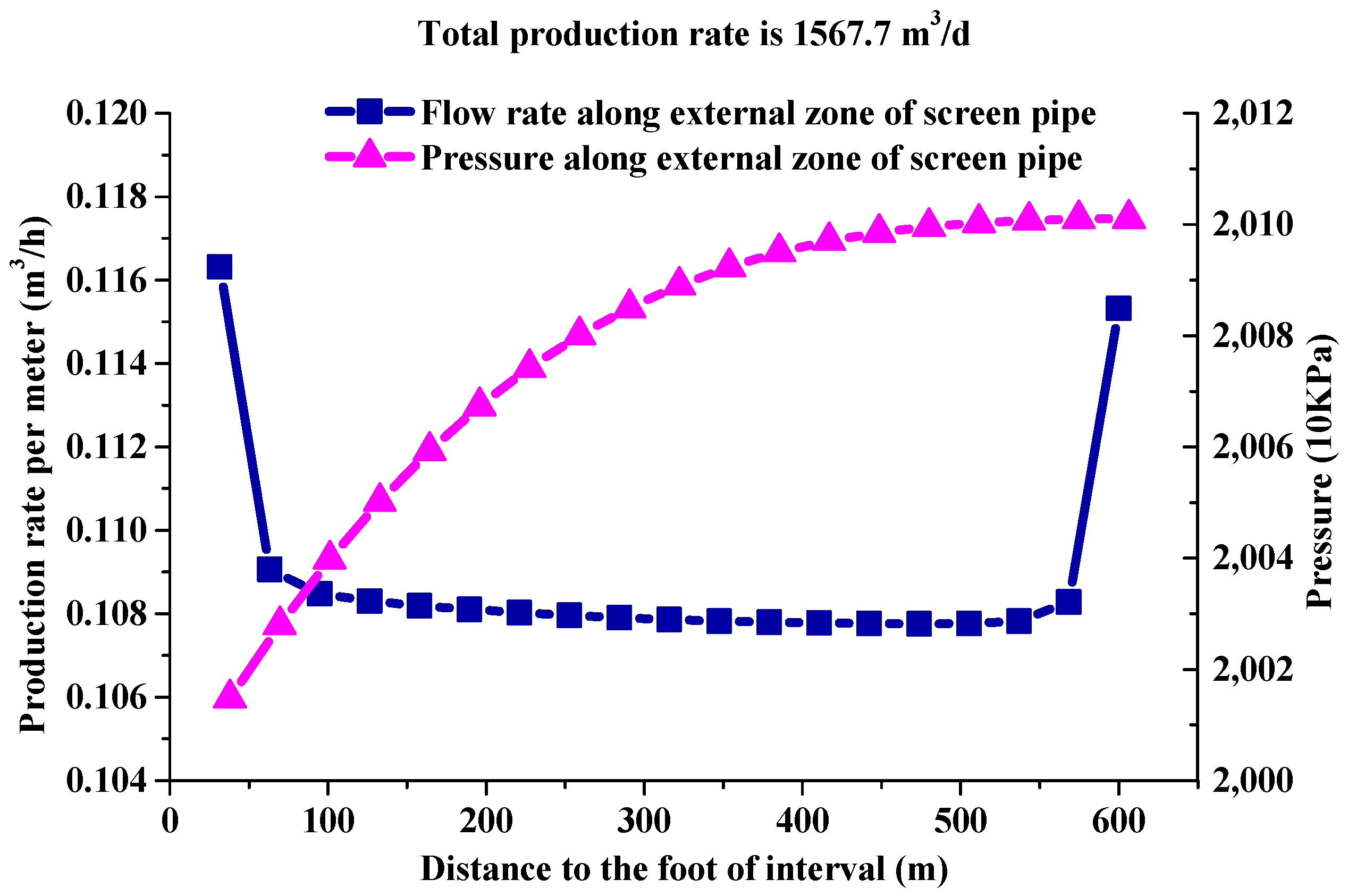

4.3. Example 2
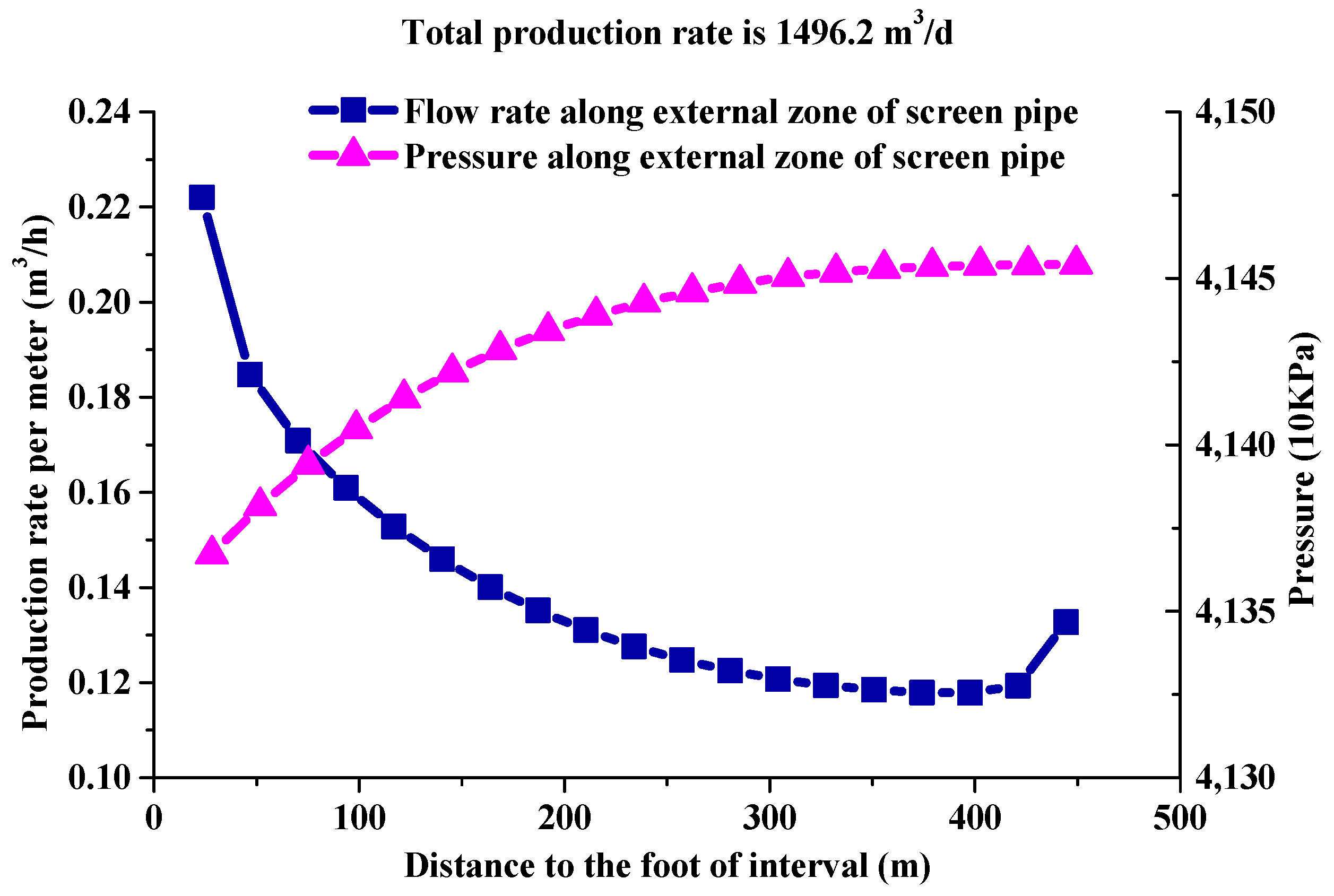

5. Conclusions
- (1)
- The numerical simulation for single-phase and multiphase variable mass flow in a horizontal wellbore reveals several key findings: (1) As the distance from the left inlet increases and the flow rate continues to rise, the pressure decreases, and the pressure drop becomes more pronounced in the segment with holes. This suggests that the presence of holes contributes to a significant pressure drop in the system. (2) When the total flow rate remains constant, an increase in the ratio of side injection velocity to main velocity leads to higher pressure losses and greater differences in friction factor before and after the injection hole. (3) With an increase in system pressure, the pressure drop in the wellbore also increases within the range of 0–10 m3/m3. However, in gas-liquid two-phase flow in a horizontal pipe with holes, the pressure drop initially decreases and then increases within the range of 10–20 m3/m3. This indicates a complex relationship between system pressure and pressure drop in the presence of gas-liquid two-phase flow. Overall, these simulations provide valuable insights into the behavior of variable mass flow in a horizontal wellbore and highlight the factors that influence pressure drop.
- (2)
- The study reveals that the commonly used smooth pipe friction factor, calculated as four times the Colebrook equation, does not align with the experimental data for single-phase liquid flow. Therefore, a new calculation formula for the friction factor in a horizontal pipe with holes is developed based on fitting the experimental data. This new formula provides a more accurate estimation of the friction factor in such systems.
- (3)
- The experimental results indicate that when the total flow rates are the same for the single-phase liquid flow, the friction factor with side hole flow is usually larger than the friction factor for only axial main flow, but the different friction factor proportion of the experimental results is basically the same as that of the simulation results and it is fairly small when the injection velocities ratio is small.
- (4)
- By analyzing the simulation data for single-phase variable mass flow, a linear regression equation is derived through fitting to describe the relationship between the mixture pressure drop caused by side flow and main flow velocity, as well as the ratio of side-main velocities. Comparing the fitting results obtained from this equation with the experimental data, it is observed that, for predicting the pressure drop in variable mass flow in horizontal wellbores, considering only the mixture pressure drop for the closest hole to the calculation section is sufficient, especially when the velocities of the injection holes are comparable. This finding simplifies the prediction of pressure drop in variable mass flow scenarios.
- (5)
- Upon analyzing the experimental results of multi-phase variable mass flow in a horizontal pipe, it is evident that using Dukler’s Case I method, commonly employed to predict pressure drop in conventional horizontal pipe multi-phase flow, leads to relatively small calculation results for a horizontal wellbore with holes. To address this, a new friction factor calculation method that takes slip into account is developed by referencing the Beggs and Brill method and considering two-phase friction. The new method incorporates slip and is obtained through fitting the experimental data for multi-phase variable mass flow in a horizontal pipe. By comparing and analyzing the experimental data and the fitting calculation results under different conditions, it becomes apparent that when the Gas-Liquid Ratios (GLRs) are relatively large, the presence of side flow does not significantly impact the pressure drop. However, when the GLRs are small, the side flow increases the pressure drop, and this increase is quite substantial in proportion. These findings highlight the importance of considering slip and the influence of side flow in accurately predicting pressure drop in multi-phase variable mass flow scenarios in horizontal wellbores.
- (6)
- The calculations of single-phase variable mass flow reveal that neglecting the mixture pressure drop can lead to significantly overestimated productivity prediction results, with production rate errors potentially exceeding 50%. The magnitude of the production rate error is dependent on the ratio of the mixture pressure drop to the production pressure differential. This finding, combined with the investigation of single-phase and multi-phase flows, suggests that when the Gas-Liquid Ratio (GLR) is low, the production rate error resulting from variable mass flow productivity predictions may be relatively large compared to the total production rate. Therefore, further research is necessary to develop a prediction method for the mixture pressure drop in gas and liquid two-phase variable mass flow scenarios.
- (7)
- When considering the mixture pressure drop, the pressure along the external zone of the screen pipe is higher compared to when the mixture pressure drop is not considered. Additionally, the flow rate along the external zone of the screen pipe is more non-uniform when the mixture pressure drop is taken into account, as opposed to when it is neglected. These observations highlight the impact of the mixture pressure drop on the pressure distribution and flow characteristics in the external zone of the screen pipe.
Author Contributions
Funding
Data Availability Statement
Acknowledgments
Conflicts of Interest
References
- Ihara, M.; Brill, J.P.; Shoham, O. Experimental and theoretical investigation of two-phase flow in horizontal wells. In Proceedings of the SPE 67th Annual Technical Conference and Exhibition, Washington, DC, USA, 4–7 October 1992; SPE24766. pp. 57–67. [Google Scholar]
- Ihara, M.; Shimizu, N. Effect of accelerational pressure drop in a horizontal wellbore. In Proceedings of the SPE 68th Annual Technical Conference and Exhibition, Houston, TX, USA, 3–6 October 1993; SPE26519. pp. 125–138. [Google Scholar]
- Ihara, M.; Kikuyama, K.; Hasegawa, Y.; Mizuguchi, K. Flow in horizontal wellbores with influx through porous walls. In Proceedings of the SPE 69th Annual Technical Conference and Exhibition, New Orleans, LA, USA, 25–28 September 1994; SPE28485. pp. 225–235. [Google Scholar]
- Ihara, M.; Yanai, K.; Yakao, S. Two-phase flow in horizontal wells. SPE Prod. Facil. 1995, 11, 249–255. [Google Scholar] [CrossRef]
- Su, Z.; Gudmundsson, J.S. Friction factor of perforation roughness in pipes. In Proceedings of the SPE 68th Annual Technical Conference and Exhibition, Houston, TX, USA, 3–6 October 1993; pp. 151–163, SPE 26521. [Google Scholar]
- Su, Z.; Gudmendsson, J.S. Pressure drop in perforated pipes: Experiments and analysis. In Proceedings of the SPE Asia Pacific Oil and Gas Conference, Melbourne, Australia, 7–10 November 1994; pp. 563–574, SPE28800. [Google Scholar]
- Su, Z.; Gudmundsson, J.S. Perforation inflow reduces frictional pressure loss in horizontal wellbores. J. Pet. Sci. Eng. 1998, 19, 223–232. [Google Scholar] [CrossRef]
- Plaxton, B.L. Pipeflow experiments for the analysis of pressure drop in horizontal wells. SPE Int. Stud. Pap. Contest 1995, 11, 635–650. [Google Scholar]
- Yuan, H. Investigation of single-phase liquid flow behavior in horizontal wells. In Proceedings of the Fluid Flow Projects Advisory Board Meeting, Tulsa, OK, USA, 9–10 May 1995; pp. 103–117. [Google Scholar]
- Yuan, H.; Sarica, C.; Brill, J.P. Effect of perforation density on single-phase liquid flow behavior in horizontal wells. In Proceedings of the 1996 International Conference on Horizontal Well Technology, Calgary, AB, Candada, 18–20 November 1996; pp. 603–612. [Google Scholar]
- Yuan, H.; Sarica, C.; Miska, S.; Brill, J.P. An experimental and analytical study of single-phase liquid flow in a horizontal well. J. Energy Resour. Technol. 1997, 119, 20–25. [Google Scholar] [CrossRef]
- Yuan, H.; Sarica, C.; Brill, J.P. Effect of completion geometry and phasing on single-phase liquid flow behavior in horizontal wells. SPE48937. In Proceedings of the 1998 SPE Annual Technical Conference and Exhibition, New Orleans, LA, USA, 27–30 September 1998; pp. 93–104, SPE48937. [Google Scholar]
- Ouyang, L.-B.; Arbabi, S.; Aziz, K. General wellbore flow model for horizontal, vertical, and slanted well completions. In Proceedings of the 1996 SPE Annual Technical Conference, Denver, CO, USA, 6–9 October 1996; pp. 349–361. [Google Scholar]
- Ouyang, L.-B.; Petalas, N.; Arbabi, S.; Schroeder, D.E.; Aziz, K. An Experimental Study of Single-Phase and Two-Phase Fluid Flow in Horizontal Wells. In Proceedings of the SPE Western Regional Meeting, Bakersfield, CA, USA, 10–13 May 1998. [Google Scholar]
- Ouyang, L.-B.; Aziz, K. A mechanistic model for gas-liquid flow in pipes and wells. In Proceedings of the 1999 SPE Annual Technical Conference and Exhibition, Houston, TX, USA, 3–6 October 1999; pp. 359–372, SPE 56525. [Google Scholar]
- Ouyang, L.-B.; Aziz, K. A homogeneous model for gas-liquid flow in horizontal wells. J. Pet. Sci. Eng. 2000, 27, 119–128. [Google Scholar] [CrossRef]
- Utvik, O.H.; Rinde, T.; Schulkes, R. Pressure drop in perforated pipe with radial inflow: Multiphase flow. In Proceedings of the 1997 Annual Technical Conference and Exhibition, San Antonio, TX, USA, 5–8 October 1997; pp. 1–15. [Google Scholar]
- Zhou, S.; Zhang, Q.; Li, M.; Wang, W. Experimental study on variable mass fluid flow in horizontal wellbore. J. China Pet. Univ. (Nat. Sci. Ed.) 1998, 5, 54–56+6. [Google Scholar]
- Wang, Z.; Xiao, J.; Wang, X.; Wei, J. Study on regularity of pressure drop for variable mass flow of horizotal well. Exp. Hydrodyn. 2011, 26–29, SPE38449. [Google Scholar]
- Bokane, A.; Jain, S.; Freddy, C. Evaluation and Optimization of Proppant Distribution in Multistage Fractured Horizontal Wells: A Simulation Approach. In Proceedings of the SPE/CSUR Unconventional Resources Conference—Canada, Calgary, AB, Canada, 30 September 2014. [Google Scholar] [CrossRef]
- Wang, Z.; Yang, J.; Zhang, Q.; Wang, X.; Gao, H.; Ceng, Q.; Zhao, Y. Evaluation of pressure drop prediction model for horizontal wellbore based on large size experiment. Pet. Explor. Dev. 2015, 238–241. [Google Scholar]
- Lei, H.; Chang, P.; Yang, X. Variable mass multiphase flow and fluid physical property analysis of fractured horizontal well in low—permeability tight gas reservoir. Complex Hydrocarb. Reserv. 2017, 10, 56–59. [Google Scholar]
- Wang, Z.; Zhang, Q.; Zeng, Q.; Wei, J. A Unified Model of Oil/Water Two-Phase Flow in the Horizontal Wellbore. SPE J. 2017, 22, 353–364. [Google Scholar] [CrossRef]
- Zhang, Q. Dispersed Flow Pressure Drop Model of Oil-Gas-Water Three-Phase Variable Mass Flow in Horizontal Perforated Wellbore. Liaoning Chem. Ind. 2020, 49, 443–445. [Google Scholar] [CrossRef]
- Colebrook, C.F. Turbulent Flow in Pipes, with Particular Reference to the Transition Region between the Smooth and Rough Pipe Laws. J. Inst. Civ. Eng. 1939, 11, 133–156. [Google Scholar] [CrossRef]
- Ye, Y. Numerical method of F.Colebrook formula in hydrodynamics. J. Guangdong Inst. Technol. 1986, 2, 113–115. [Google Scholar]
- Manning Francis, S.; Thompson Richard, E. Oilfield Processing of Petroleum, Vol. 1: Natural Gas; PennWell Books: Tulsa, OK, USA, 1991; p. 293. [Google Scholar]
- Asheim, H.; Kolnes, J.; Oudeman, P. A flow resistance correlation for completed wellbore. J. Pet. Sci. Eng. 1992, 8, 97–104. [Google Scholar] [CrossRef]
- Brown, K.E.; Beggs, H.D. Oil Production with Lifting Approach; Petroleum Industry Press: Beijing, China, 1987; Volume I, pp. 221–241. [Google Scholar]
- Beggs, H.D.; Brill, J.P. A Study of Two-phase Flow in Inclined Pipes. J. Pet. Tech. 1973, 25, 607–617. [Google Scholar] [CrossRef]
- Liu, X.; Guo, C.; Jiang, Z.; Liu, X.; Guo, S. The model coupling fluid flow in the reservoir with flow in the horizontal wellbore. Acta Pet. Sin. 1999, 20, 82–86. [Google Scholar]
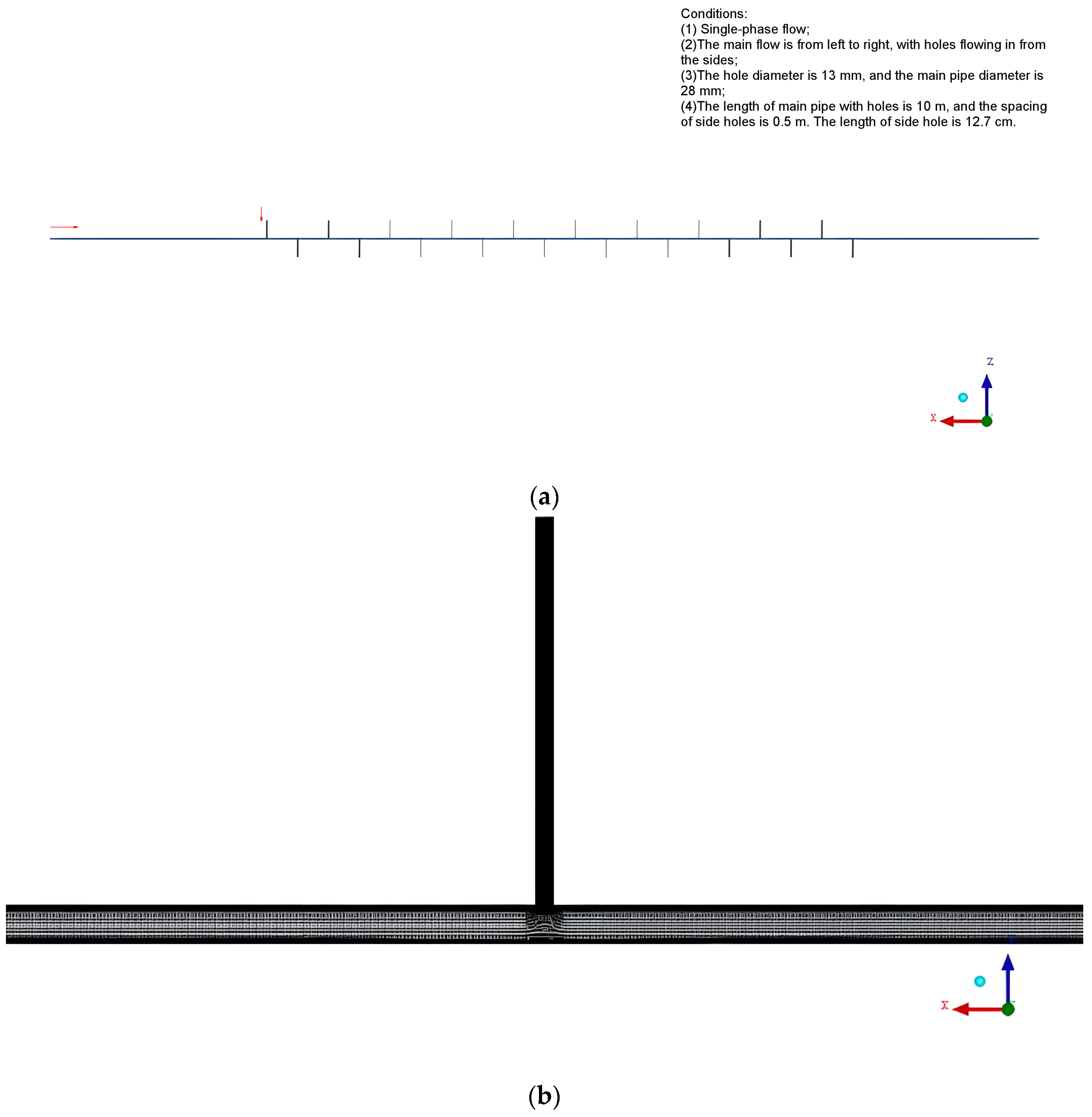



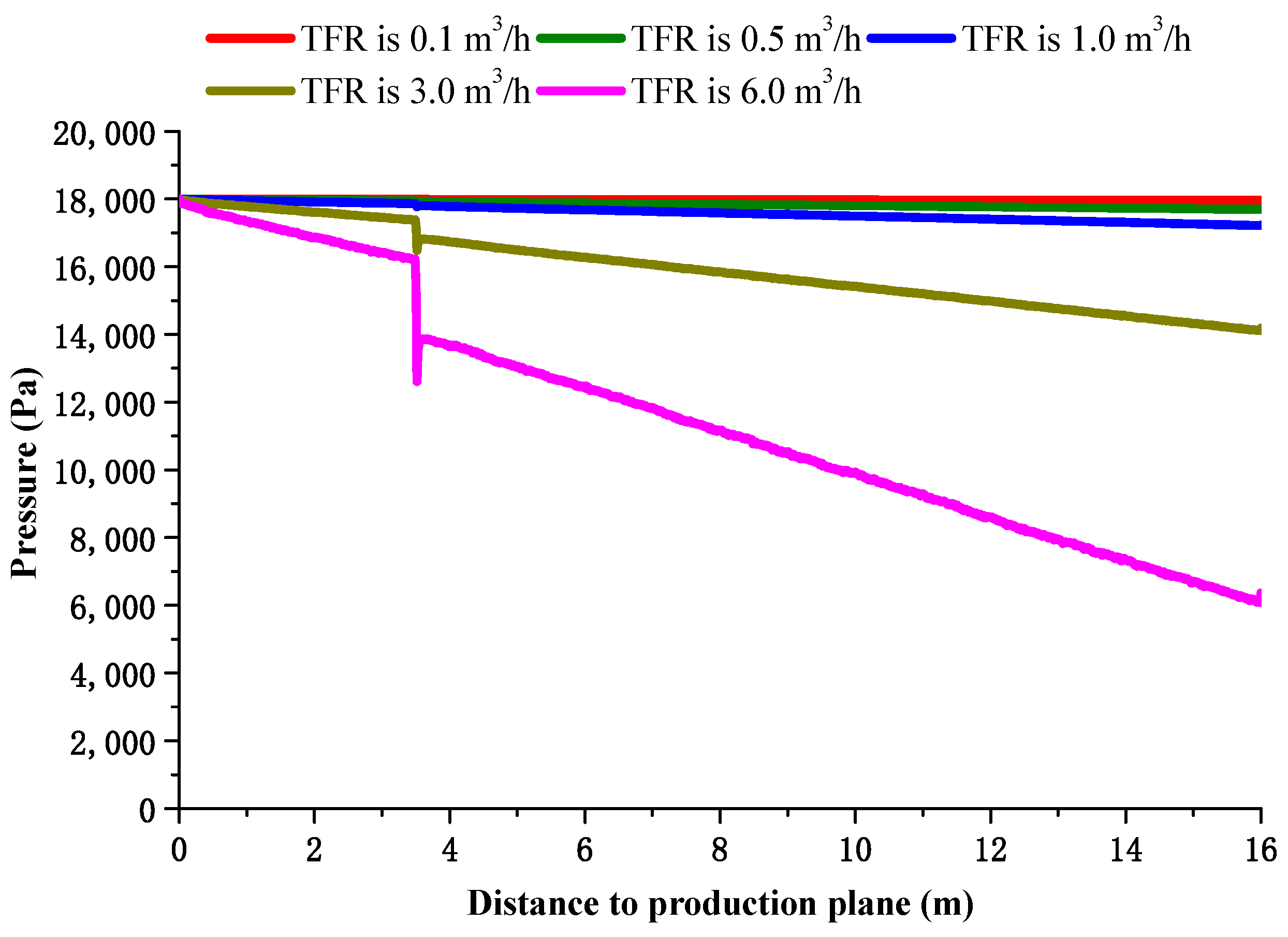
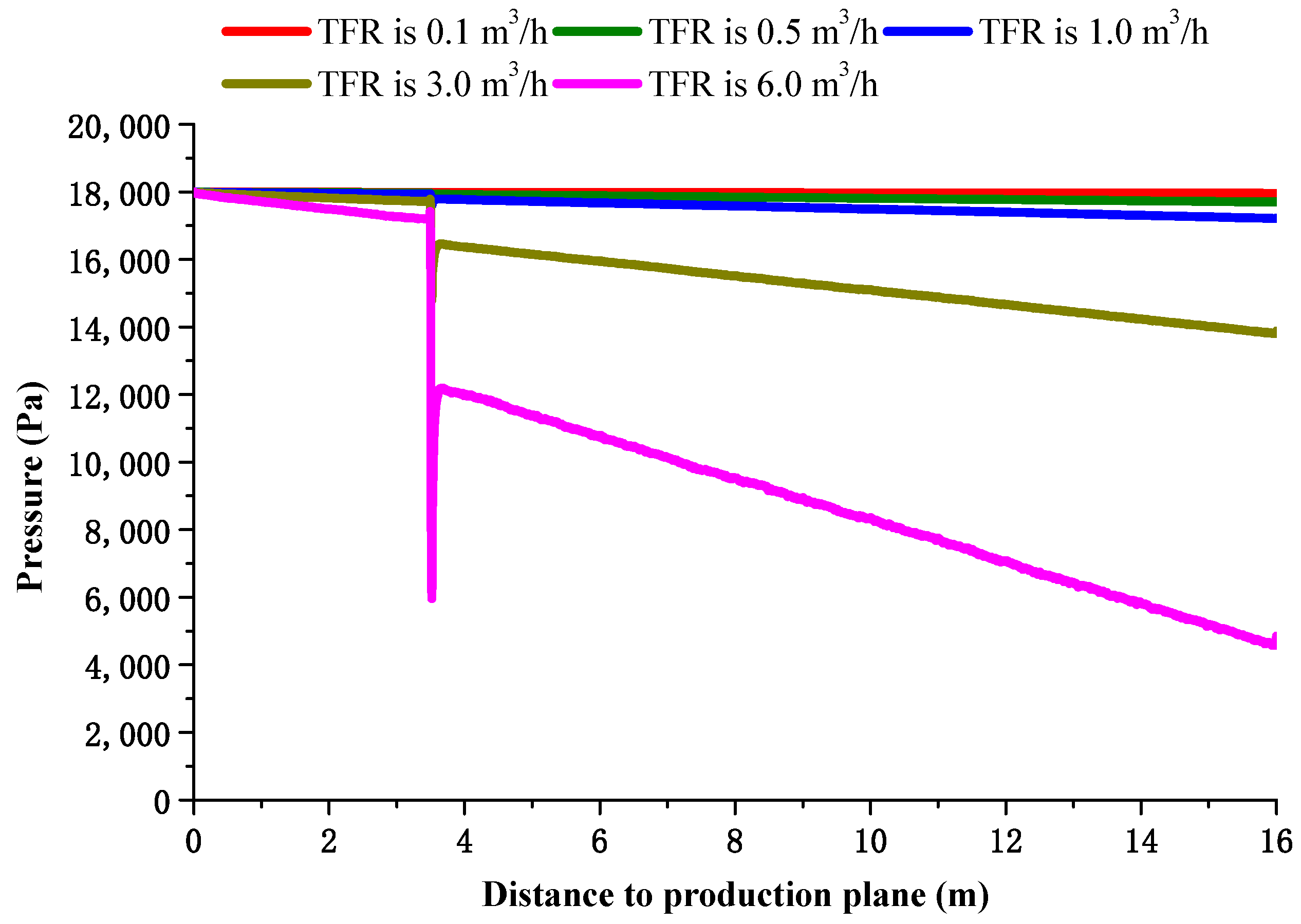

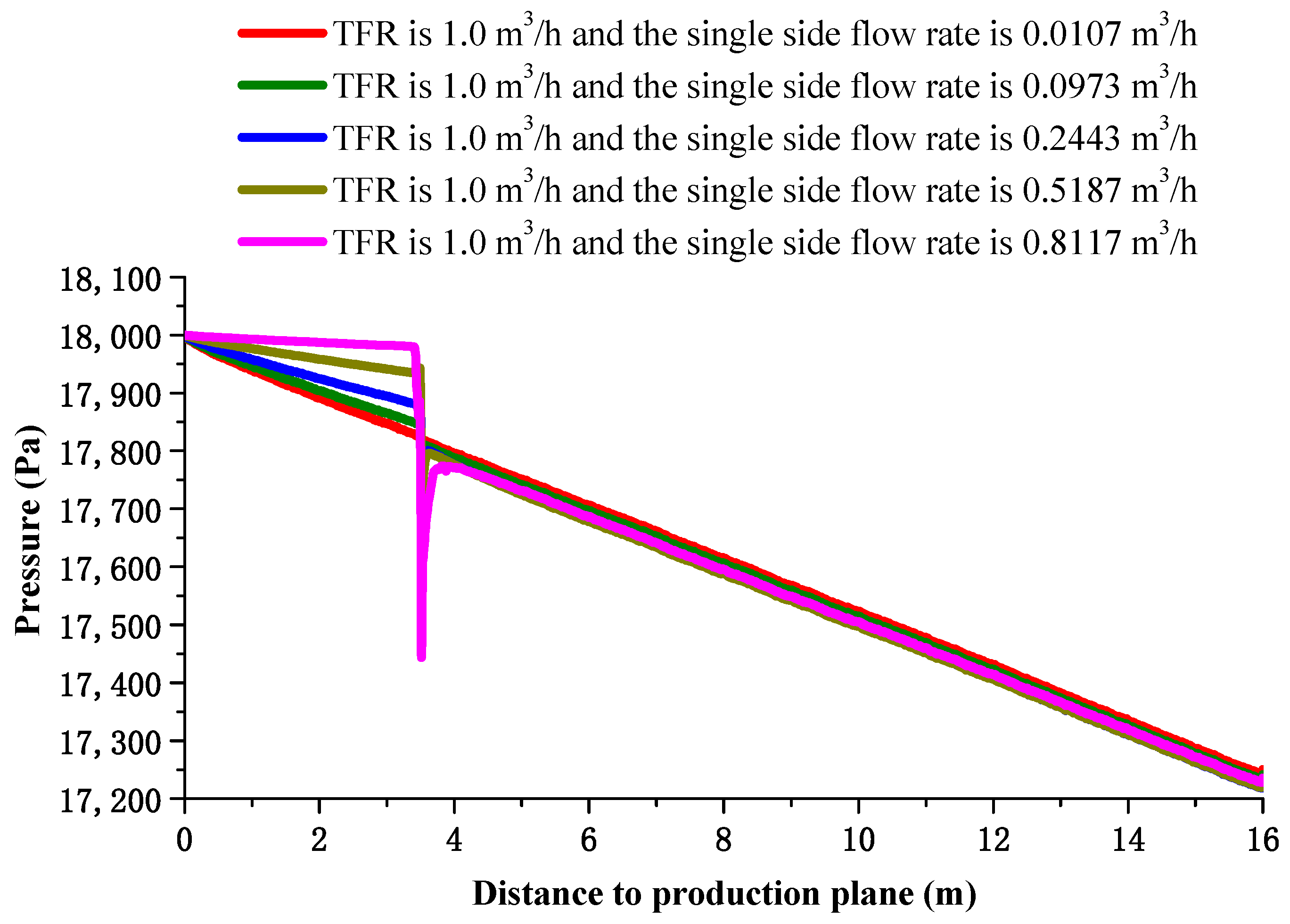
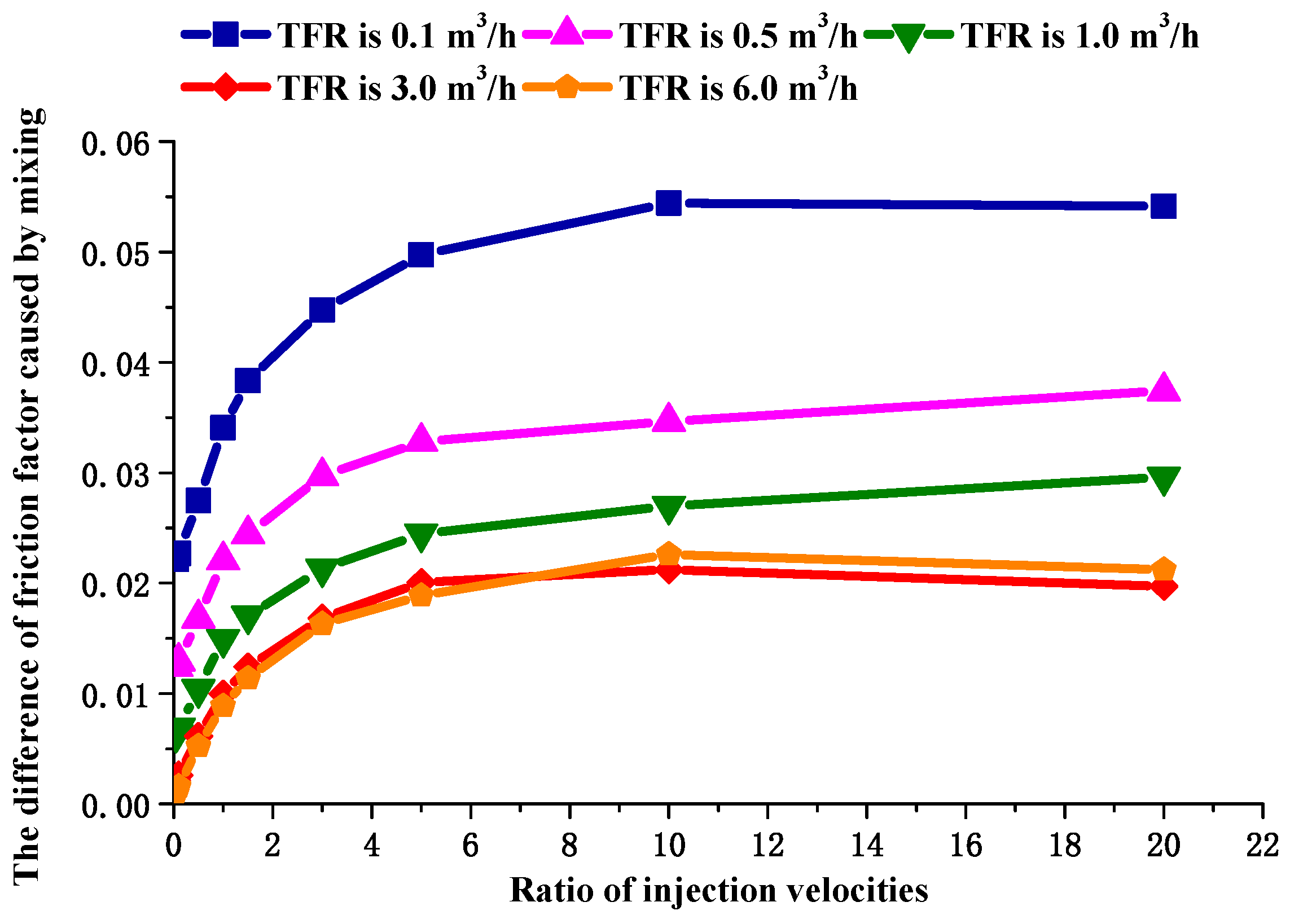
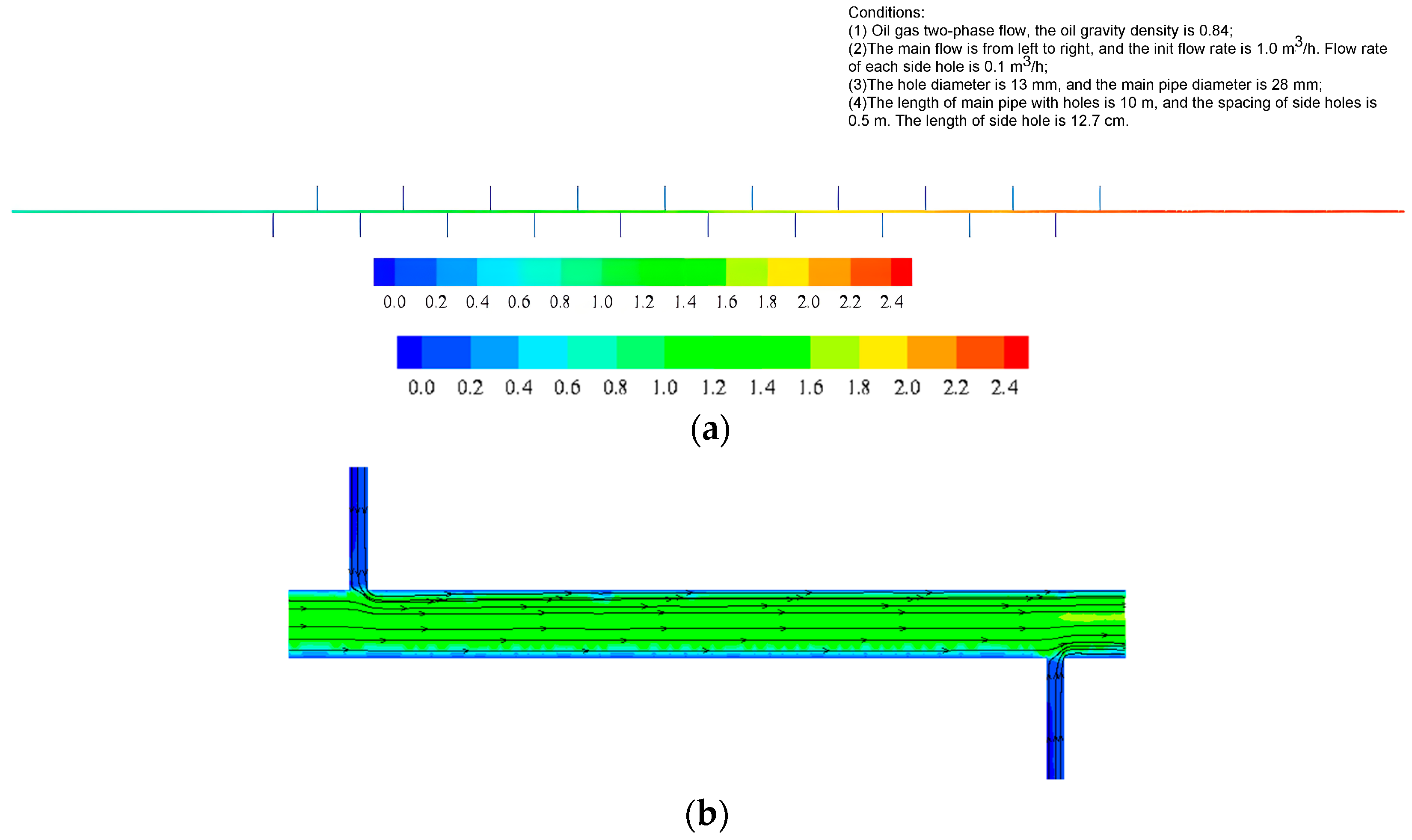

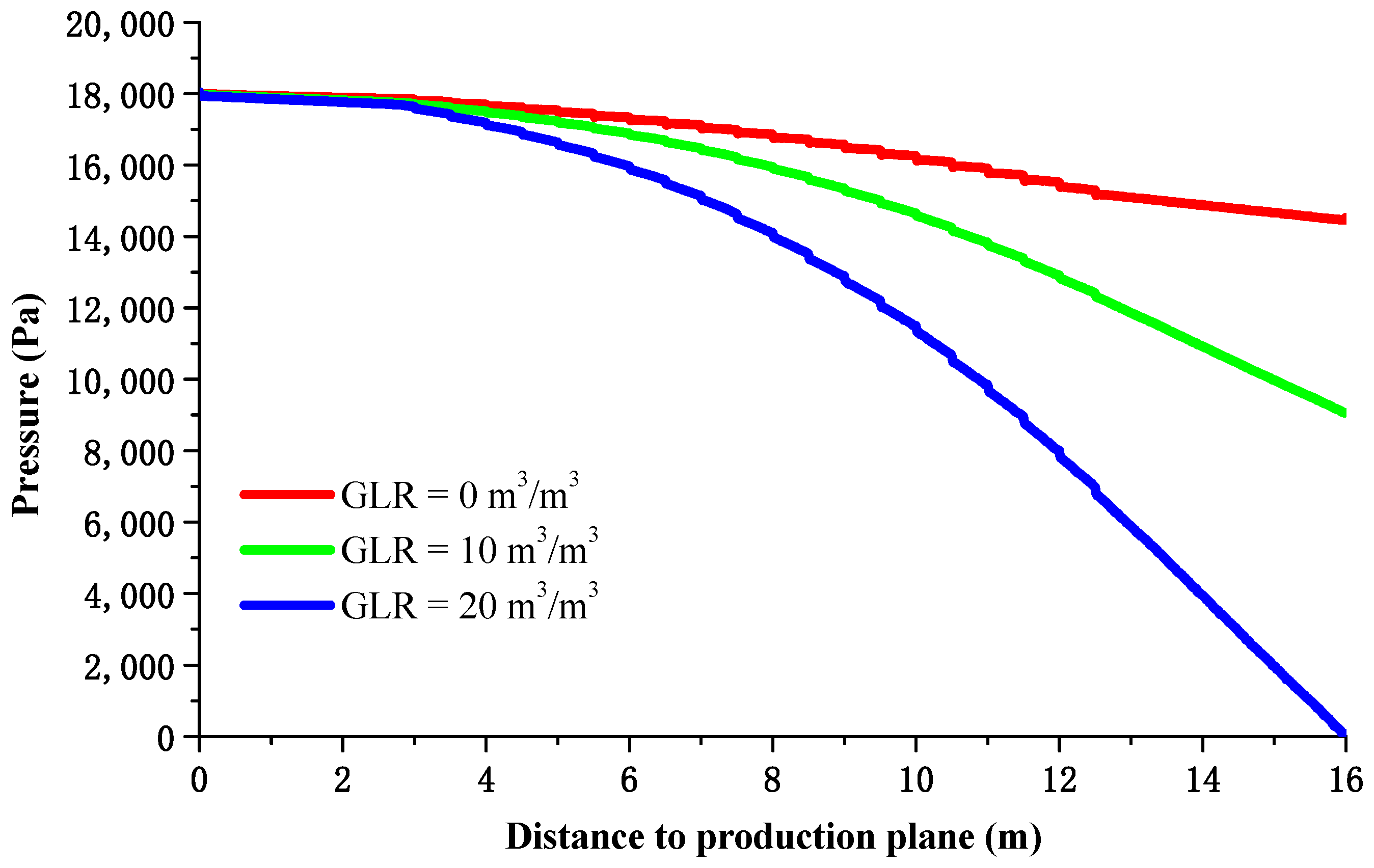
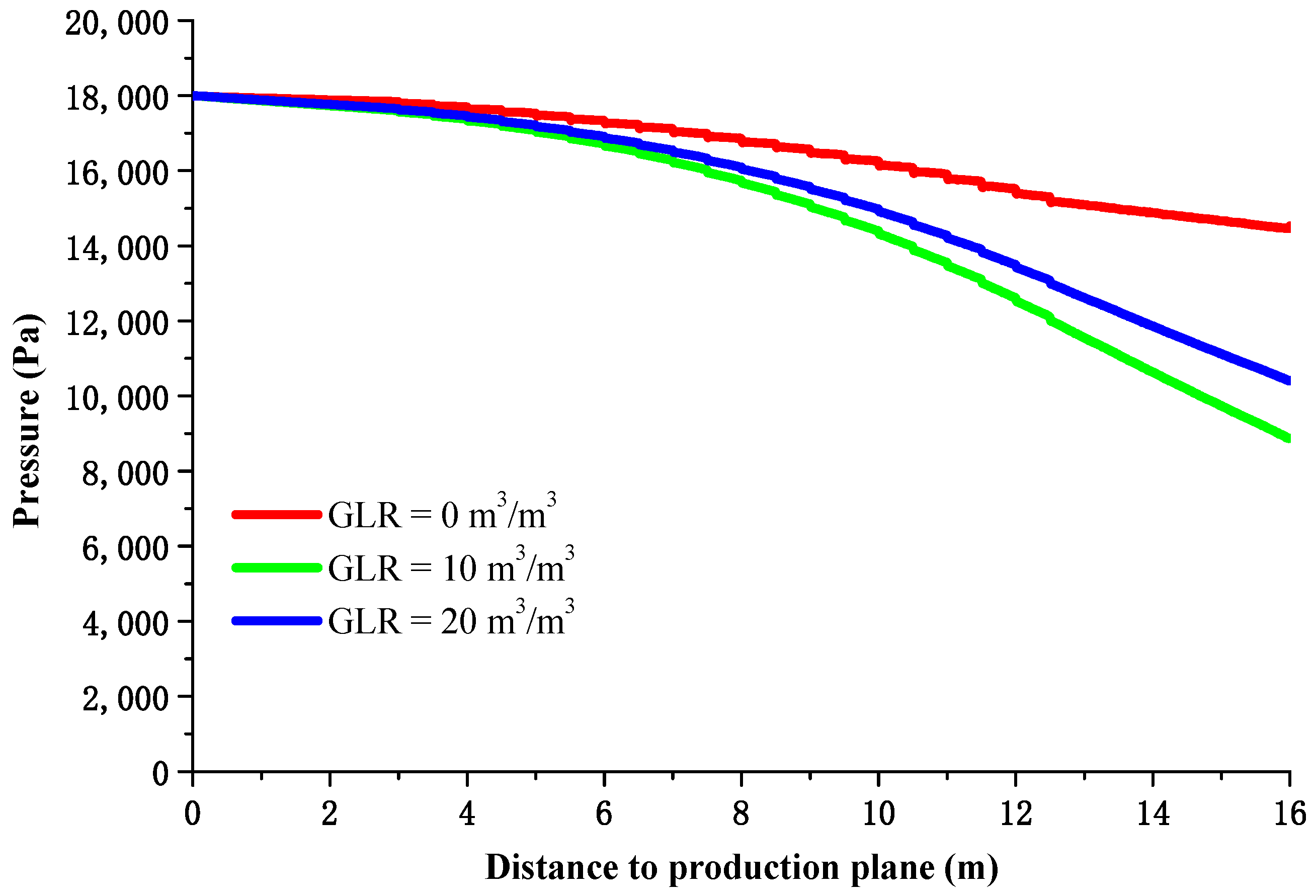

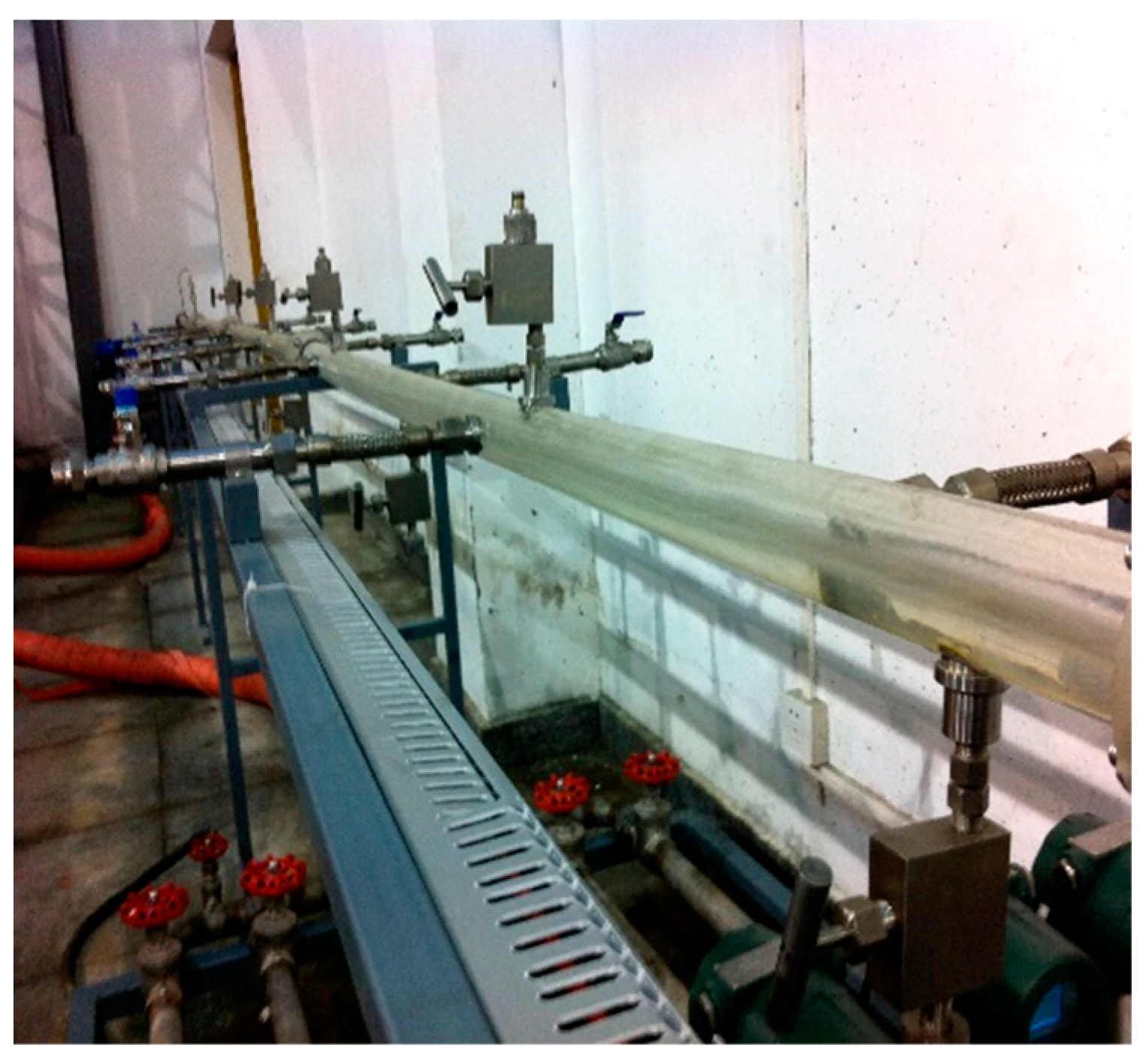



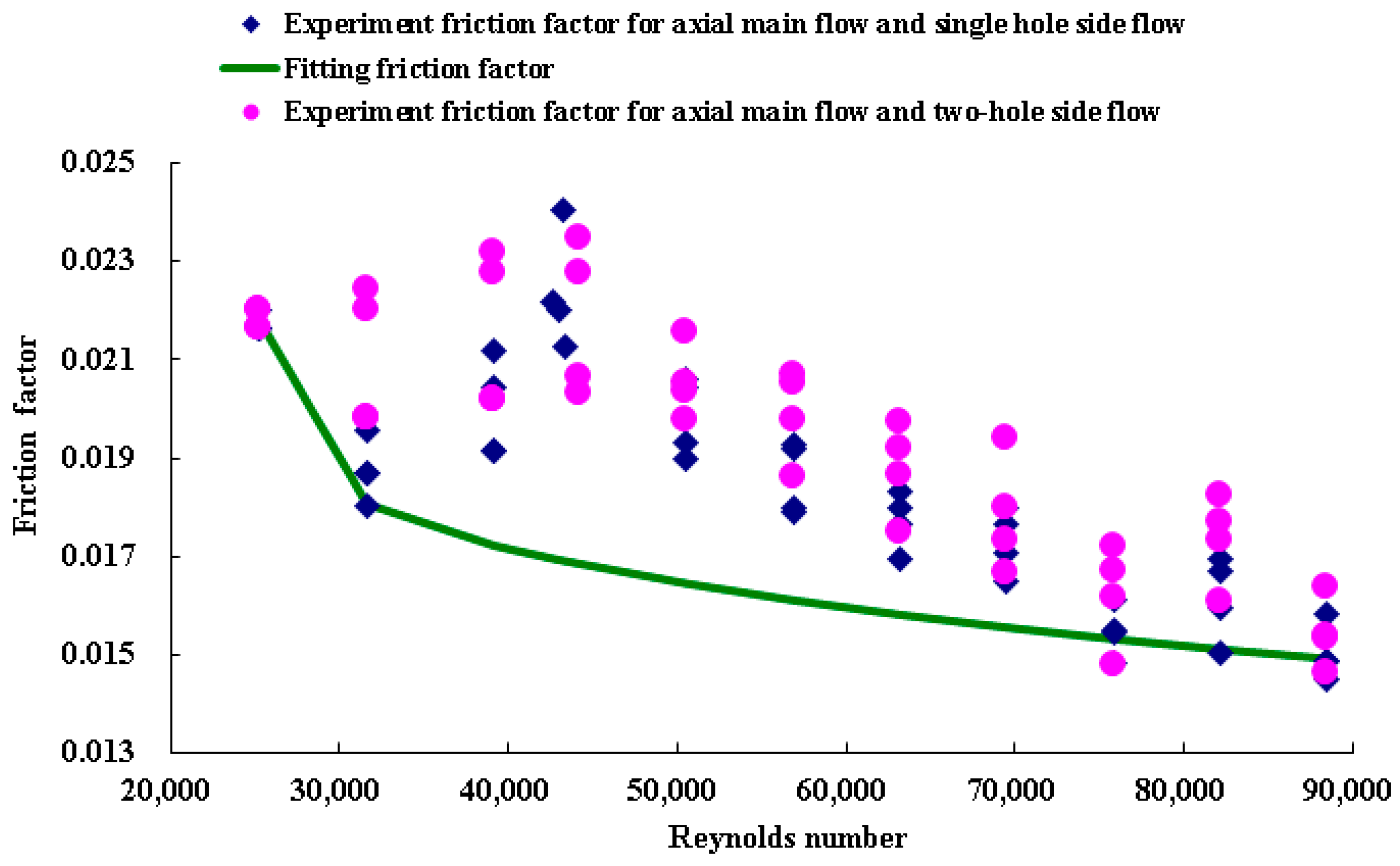
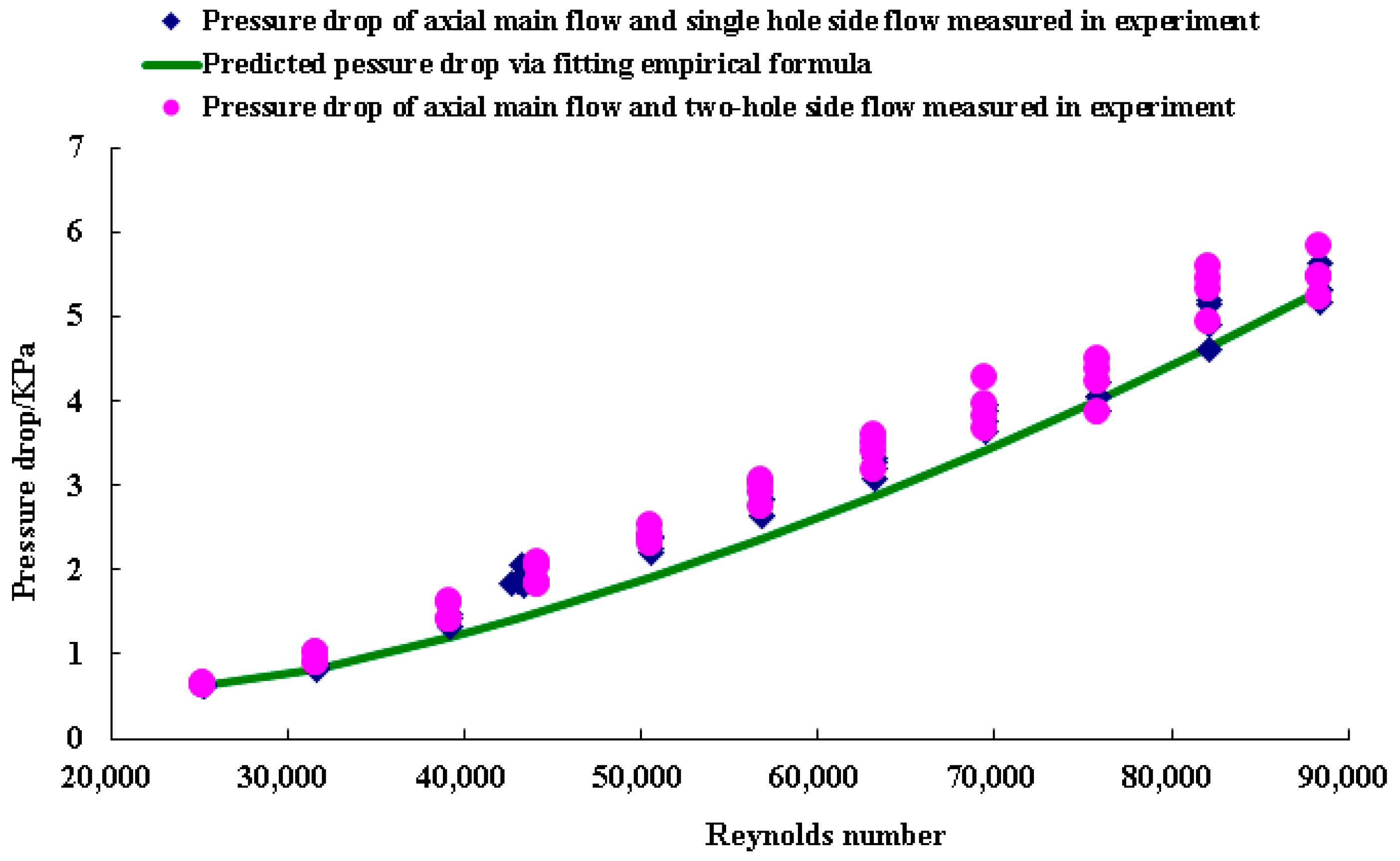
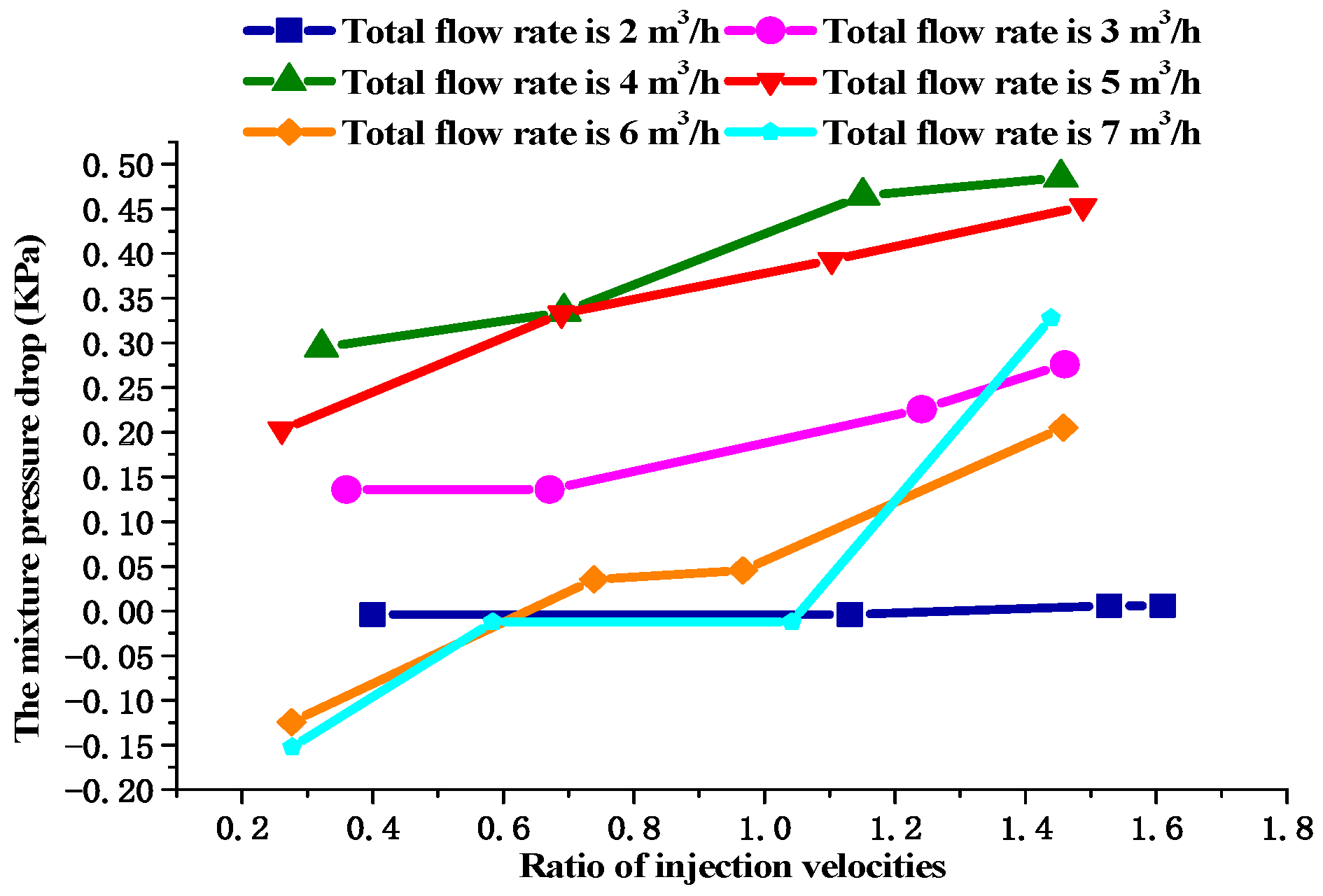



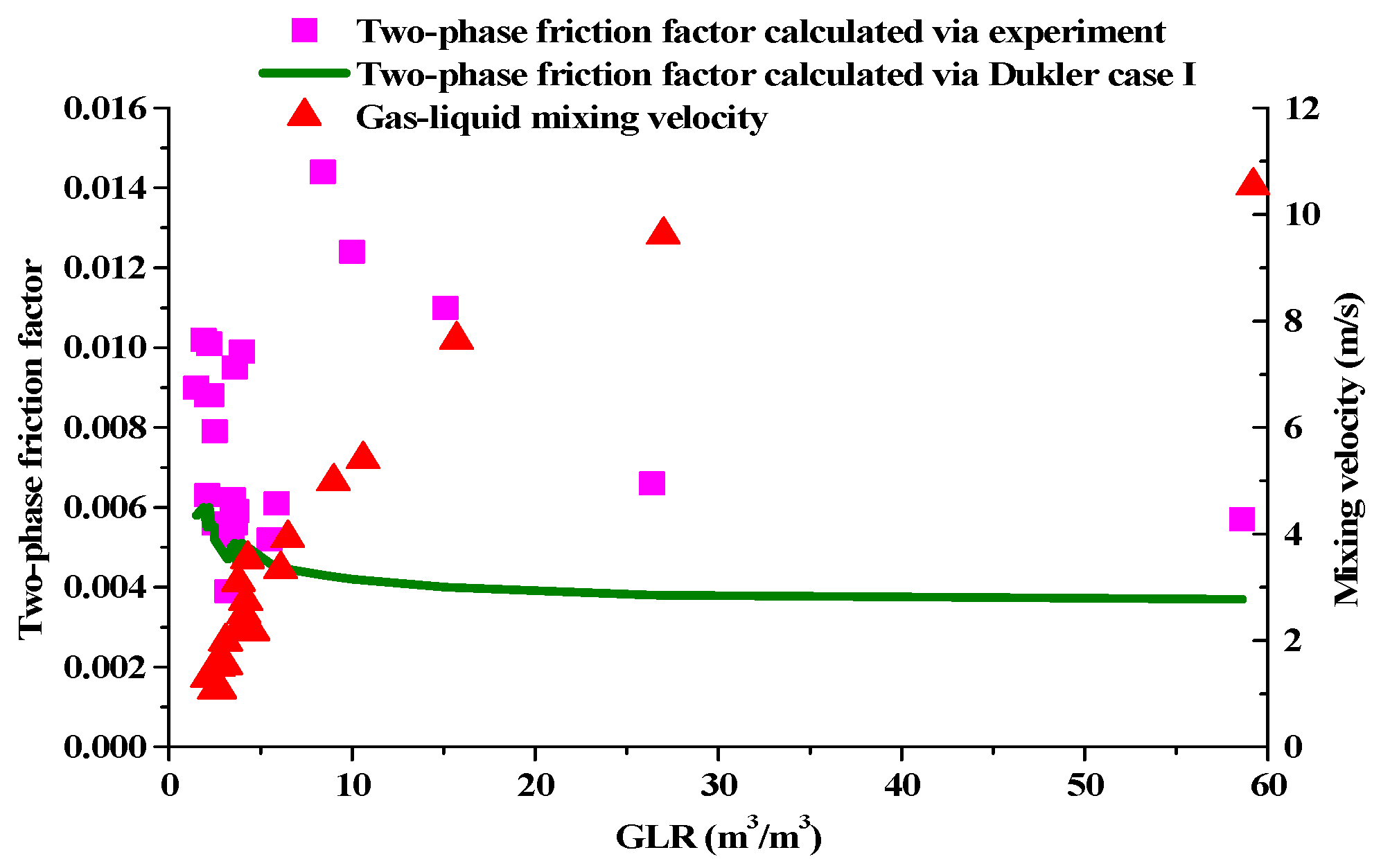

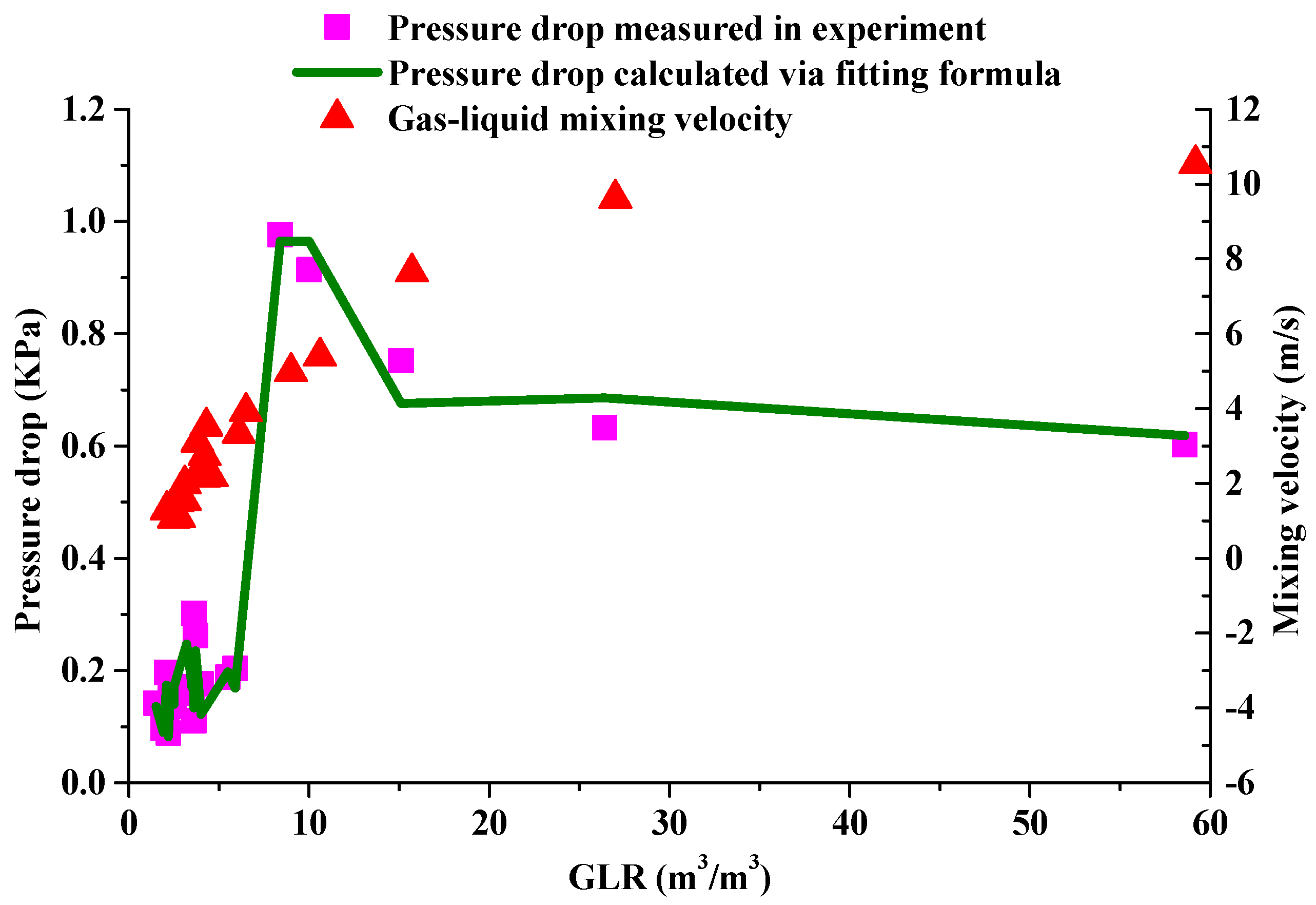
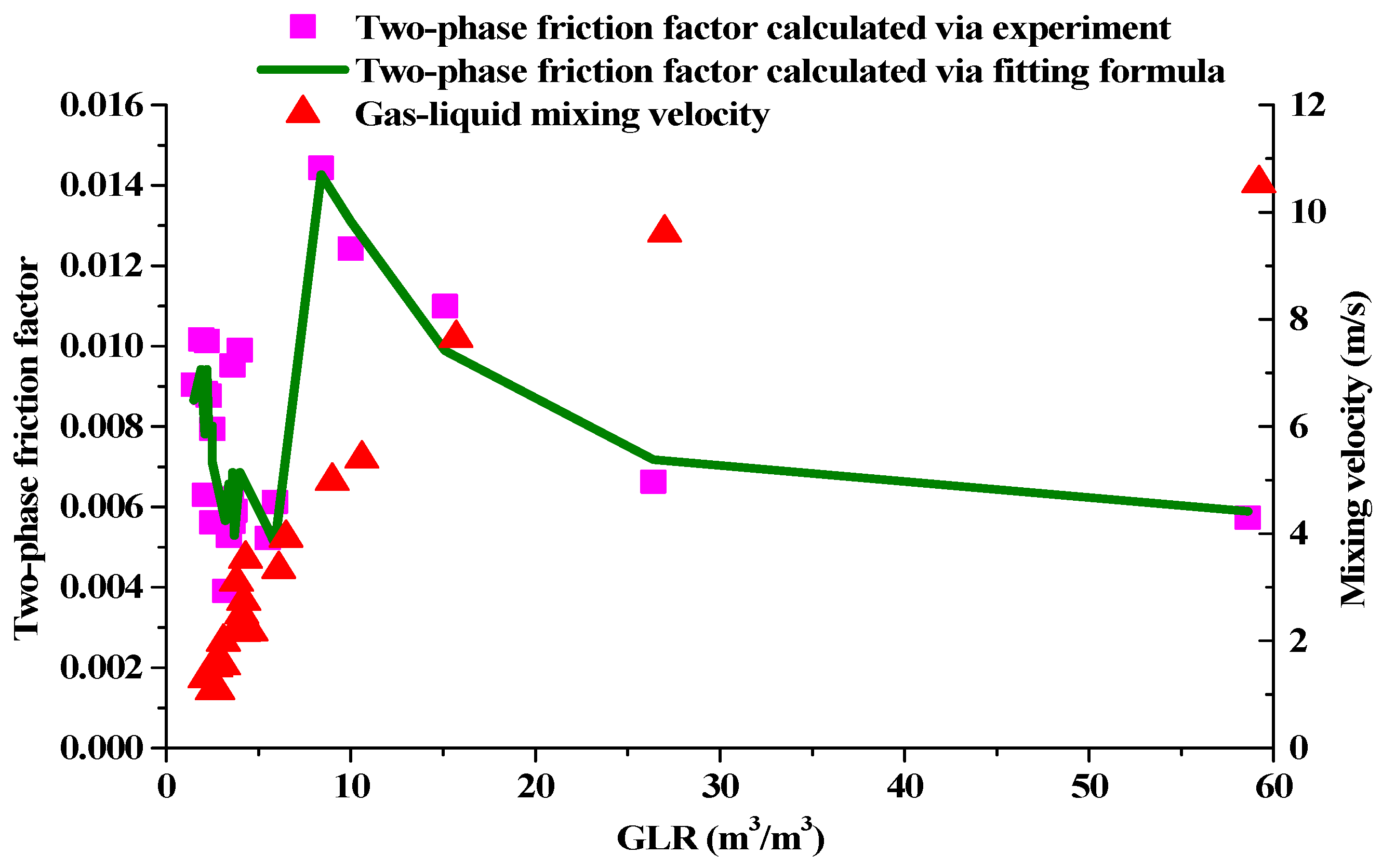
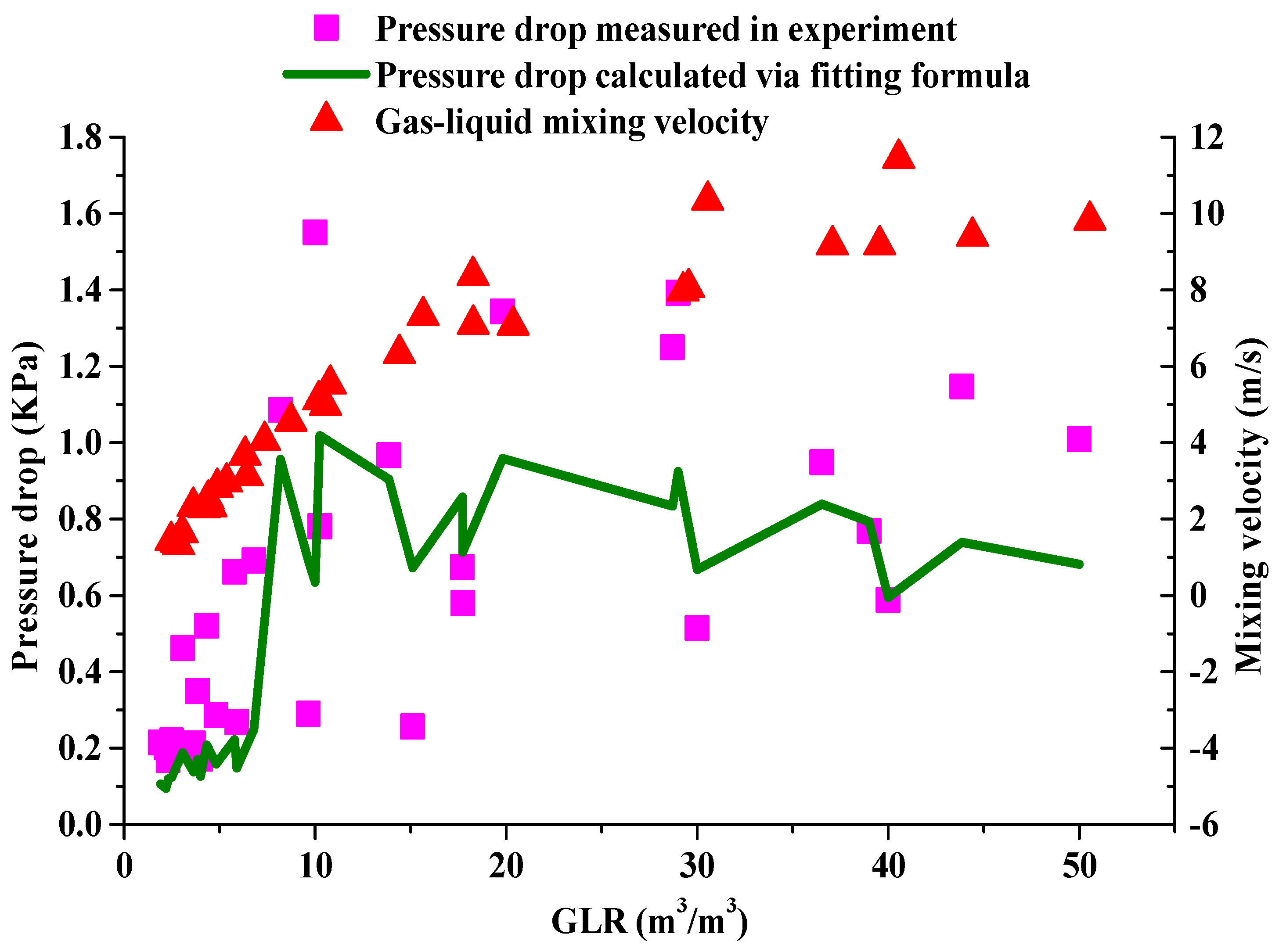
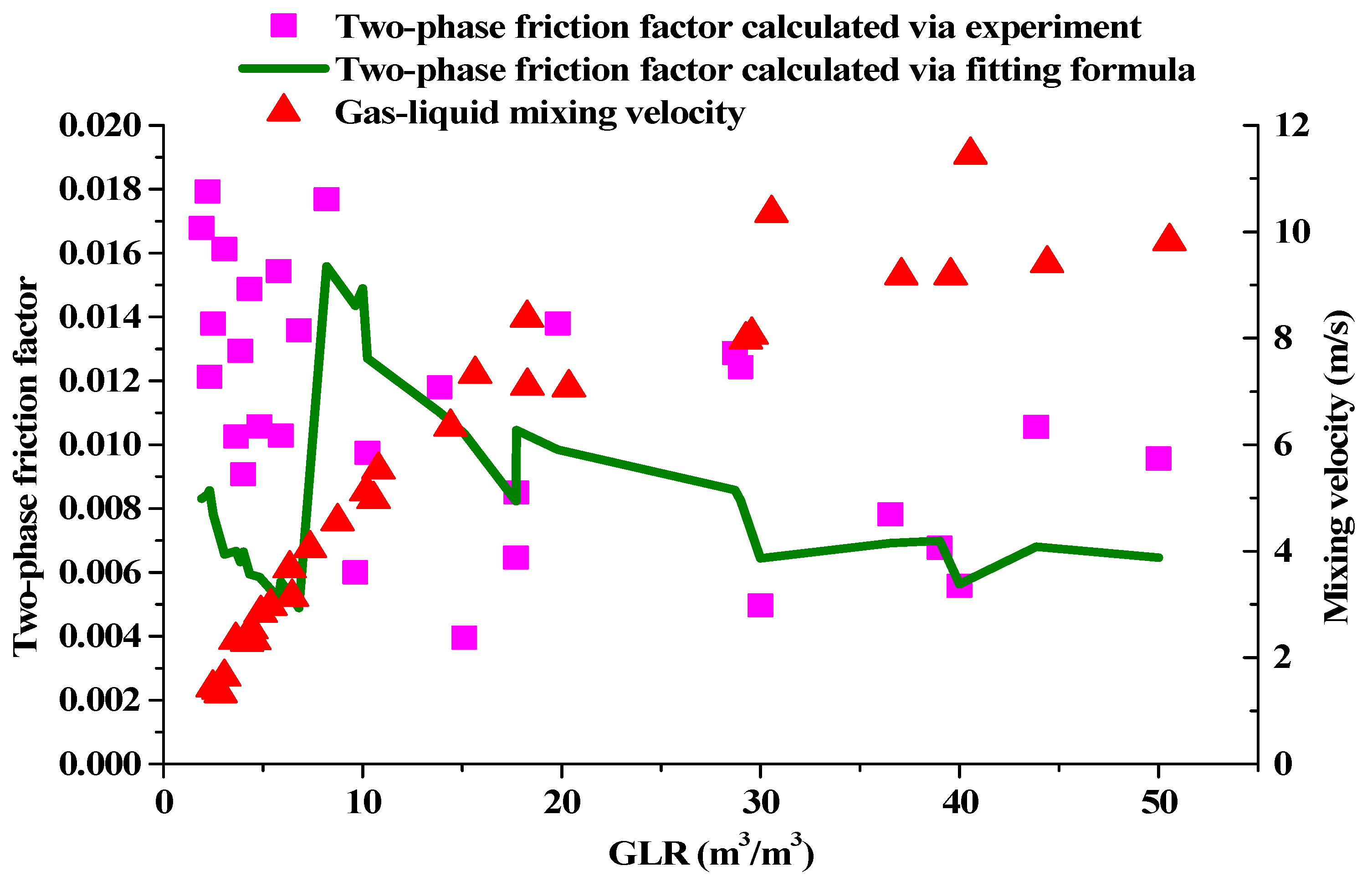
| Equipment Type | Measurement Range | Measurement Accuracy |
|---|---|---|
| Liquid turbine flowmeter in axial pipe | 0.0~6.0 m3/h | ±0.5% |
| Differential pressure gauge | 0.0~15.0 KPa | ≤1.0 KPa |
| Gas thermal mass flowmeter in axial pipe | 0.0~10.0 m3/min | ±1.0% |
| Liquid turbine flowmeter in side pipe | 0.0~1.2 m3/h | ±0.5% |
| Gas thermal mass flowmeter in side pipe | 0.0~2.0 m3/min | ±1.0% |
| Liquid Phase Flow Rate (m3/h) | Pipe Diameter (m) | Liquid Phase Flow Velocity (m/s) | Type | Range of the Liquid Phase Flow Rate at Same Flow Velocity for 4-1/2” Screen Pipe (m3/d) |
|---|---|---|---|---|
| 1–7 | 0.028 | 0.451–3.159 | Single-phase horizontal pipe flow | 331.1–2317.7 |
| 2–7 | 0.028 | 0.903–3.159 | Single-phase variable mass flow | 662.2–2317.7 |
| 0.2–1.7 | 0.028 | 0.092–0.761 | Multi-phase variable mass flow | 68.2–558.8 |
| Initial Horizontal Permeability | 13.4 | mD | Eccentric Distance | 0 | m |
| Initial vertical permeability | 1.34 | mD | Length of horizontal well | 600 | m |
| Wellbore diameter | 0.149 | m | Reservoir thickness | 30 | m |
| Crude viscosity | 1.62 | mPa.s | Crude density | 0.794 | g/cm3 |
| Crude volume factor | 1.35 | Formation pressure | 31.13 | MPa | |
| Screen diameter | 0.114 | m |
| Initial Horizontal Permeability | 164 | mD | Eccentric Distance | 5.25 | m |
| Initial vertical permeability | 49.2 | mD | Length of horizontal well | 444.4 | m |
| Wellbore diameter | 0.103 | m | Reservoir thickness | 33.5 | m |
| Crude viscosity | 0.29 | mPa·s | Crude density | 0.84 | g/cm3 |
| Crude volume factor | 1.615 | Formation pressure | 41.6 | MPa | |
| Screen diameter | m |
Disclaimer/Publisher’s Note: The statements, opinions and data contained in all publications are solely those of the individual author(s) and contributor(s) and not of MDPI and/or the editor(s). MDPI and/or the editor(s) disclaim responsibility for any injury to people or property resulting from any ideas, methods, instructions or products referred to in the content. |
© 2023 by the authors. Licensee MDPI, Basel, Switzerland. This article is an open access article distributed under the terms and conditions of the Creative Commons Attribution (CC BY) license (https://creativecommons.org/licenses/by/4.0/).
Share and Cite
Luo, W.; Ke, W.; Liao, R. Numerical Simulation and Experimental Investigation of Variable Mass Flow in Horizontal Wellbores: Single-Phase and Multiphase Analysis. Energies 2023, 16, 6073. https://doi.org/10.3390/en16166073
Luo W, Ke W, Liao R. Numerical Simulation and Experimental Investigation of Variable Mass Flow in Horizontal Wellbores: Single-Phase and Multiphase Analysis. Energies. 2023; 16(16):6073. https://doi.org/10.3390/en16166073
Chicago/Turabian StyleLuo, Wei, Wenqi Ke, and Ruiquan Liao. 2023. "Numerical Simulation and Experimental Investigation of Variable Mass Flow in Horizontal Wellbores: Single-Phase and Multiphase Analysis" Energies 16, no. 16: 6073. https://doi.org/10.3390/en16166073





